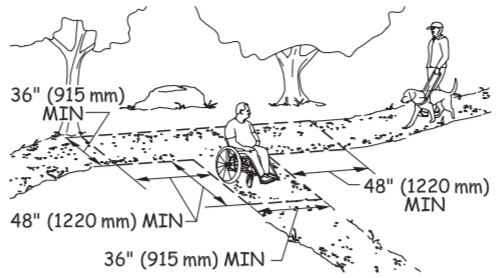Outdoor Developed Areas: A Summary of Accessibility Standards for Federal Outdoor Developed Areas
Passing Spaces [1016.4]
Where the clear width of an ORAR is less than 60 inches, passing spaces must be provided at intervals of at least 200 feet.
Passing spaces must be:
-
A minimum space of 60 by 60 inches or
-
The intersection of two ORARs that provide a T-shaped space that complies with section 304.3.2 of the ABA Standards, where the base and the arms of the T-shaped space extend a minimum of 48 inches beyond the intersection (figure 12)
Either of these configurations provides enough space for people using mobility devices to move to the side and let other people pass along the ORAR.

Figure 12—A T-intersection may be used as a passing space on an outdoor recreation access route or a beach access route if it has the dimensions shown (or larger).
Consider providing either a minimum clear width of 60 inches or passing spaces at shorter intervals where an ORAR is heavily used or adjoins elements, spaces, or facilities that are heavily used. Also, consider providing a minimum clear width of 60 inches if the ORAR is a boardwalk or otherwise not at the same level as the adjoining ground surface or if the edge is bordered by timbers or edge protection.
When the intersection of two ORARs serves as a passing space, the vertical alignment of the routes at the intersection that form the T-shaped space must be nominally planar (i.e., as flat as possible) so that all the wheels of a mobility device touch the ground when turning into and out of the passing space.
Passing spaces and resting intervals can overlap. When passing spaces and resting intervals overlap, the technical requirements for resting intervals apply and the slope of the surface must be no steeper than 1:48 (2 percent) in any direction when the ORAR is constructed of concrete, asphalt, or boards. When the surface is constructed of materials other than asphalt, concrete, or boards, slopes no steeper than 1:20 (5 percent) are allowed when necessary for drainage. Otherwise, passing-space surfaces must have the same slopes as the adjoining ORAR.

User Comments/Questions
Add Comment/Question